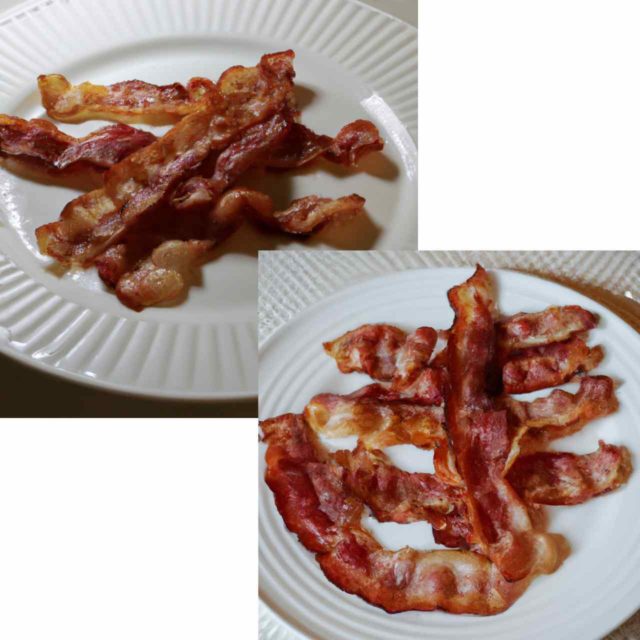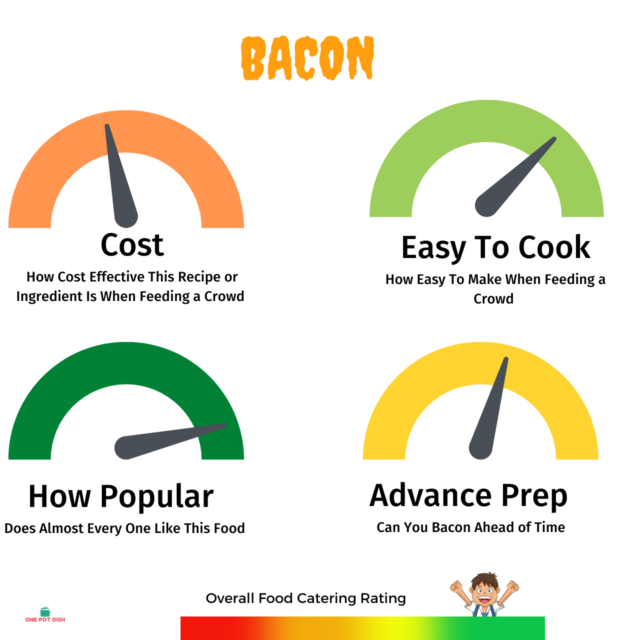How to Know When You Have Cooked Bacon
Bacon has been around for thousands of years (see the timeline of bacon through the ages) and is a delectable and versatile food that can be cooked in many different ways. However, because bacon is high in fat, it is necessary to cook it properly to avoid making it unhealthy; plus, rendering the bacon fat enhances the taste.
There are many different ways to tell if bacon is cooked properly. You know that delicious smell when bacon is cooking? It’s tempting just to let it keep going until it’s nice and crispy, but if you’re not careful, you can easily overcook your bacon and end up with something that’s burnt to a crisp.
So how can you tell when raw bacon is turned from uncooked bacon into freshly delicious bacon cooked perfectly?
These bacon cooking principles apply to streaky bacon and Canadian bacon, almost all types and strips of bacon as they morph into a brown color.
Do not be alarmed however, if your cooked bacon shrinks, it may loose 35-40% as the fat is cooked.
How to Tell That Bacon is Totally Done
Cooking bacon is easy, but there’s a bit of a learning curve. Here are four tips on how to tell that your bacon is thoroughly cooked:
Texture
Check the texture. Bacon slices should be crispy but not burnt. It must be cooking a bit longer if it’s still soft or chewy.
Color
Look at the color. The fat in fresh bacon should be rendered, and the meat should look golden brown. If it’s still pale, it needs more time.
Shape
Shape matters. Bacon should be flat and evenly cooked. It requires to be cooked a bit longer if it’s curled up or uneven.
Moisture
Check for moisture. Bacon should be dry but not crumbly. It must cook a bit longer if it’s still wet or greasy.
With these four tips, you’ll be a bacon-cooking expert in no time!

Do You Need the Meat Thermometer For Bacon?
Well, the answer is both yes and no.
On the one hand, you can use the meat thermometer for cooking bacon. In fact, it’s one of the best ways to ensure that your bacon is perfectly cooked every time. Simply insert the thermometer into the center of the bacon strip and cook until it reaches the desired temperature. Remember, bacon is done if the internal temperature reaches 145 degrees Fahrenheit. Use the meat thermometer to check doneness, and cook for longer if necessary.
On the other hand, you don’t necessarily need the meat thermometer to cook bacon. If you’re confident in your ability to gauge when bacon is thoroughly cooked to your liking, then feel free to go without one. Just keep in mind that without the meat thermometer, there’s always a risk of under or over-cooking your bacon.
So, there you have it! You can use the meat thermometer for bacon, but you don’t necessarily need one. Just use whichever method you feel most comfortable with.
Is Bacon Cooked if it’s Not Crispy?
The crispy bacon is often seen as the gold standard, but that doesn’t mean it’s the only way to enjoy this delicious food. In fact, bacon can be just as delicious when it’s not crispy and can always be made into a thanksgiving bacon butter recipe.
So, if you’re wondering, “does bacon must be crispy?” the answer is no! Here are some of the reasons why:
1. Non-crispy bacon can be just as flavorful.
If you’re only concerned with flavor, then you’ll be happy to know that non-crispy bacon can be just as delicious. The key is to cook it until it’s nicely browned and caramelized. This will give it a deep, rich flavor that is just as satisfying as crispy bacon.

2. Non-crispy bacon is easier to chew.
If you have trouble chewing or digesting crispy bacon, then you’ll be happy to know that non-crispy bacon is much easier on the tummy. It’s also a good option for people who have dentures or other dental problems.
3. Non-crispy bacon is less messy.
Let’s face it; crispy bacon can be a bit of a pain to eat. It tends to crumble and can make quite a mess. Non-crispy bacon stays together nicely and is much less messy to eat.
So, there you have it! These are just a few reasons why non-crispy bacon can be just as delicious as crispy bacon. So, the next time you’re wondering, “does bacon must be crispy?” remember that the answer is no but ensure that it shouldn’t be undercooked as well! Enjoy your bacon however you like it, whether it’s crispy or non-crispy!
Can You Undercook Bacon?
Yes, bacon can be undercooked – and it can still be delicious! The key is to cook it until it’s crisp but not burnt.
How to Make Not the Usual Crispy Bacon?
You can do different ways to make bacon not crispy. One way is to cook in your oven at a lower temperature. This will make the bacon less crispy. Another way is to cook the bacon in your pan on low to medium heat. This will also make the bacon less crispy. Finally, you can microwave the bacon on a low setting. This will make the bacon less crispy as well.
When To Flip Bacon?
It depends on the thickness of your bacon. For thin bacon, flip after about 2 minutes. For medium-thick bacon, flip after 3 minutes. And for thick bacon, flip after 4 minutes.
How Long To Cook Bacon?
The cooking time for bacon will vary based on how thick the pieces are. For thin bacon, cook for a total of 4 minutes. For medium-thick bacon, cook for 6 minutes. And for thick bacon, cook for 8 minutes. Air fryer bacon is one of the best ways to cook bacon.
The Different Colors of Bacon
Have you ever wondered why bacon comes in different colors? It turns out that there are several reasons why bacon can vary in hue. Let’s take a closer look at the different colors of bacon and what causes them.
Black Bacon
If you’ve ever seen black bacon, you may have thought it was burnt. However, black bacon is actually a type of Chinese specialty bacon that’s been cured with tea and spices. This curing process gives the bacon a deep, rich flavor that some people love. If you’re looking to try something new, black bacon might be worth a shot!
Green Bacon
You may have seen green bacon on St. Patrick’s Day or at a themed party. Green bacon is simply regular bacon that’s been dyed green. While it may not be the most appetizing color, it can be a fun way to change things up. If you’re feeling adventurous, why not give green bacon a try?
Iridescent Bacon
If you’ve ever seen iridescent bacon, you may have thought it was spoiled. However, this is not the case! Iridescent bacon is actually a type of bacon that’s been cured with salt and sugar. This curing process gives the bacon a glossy, iridescent sheen. While it may not be everyone’s cup of tea, it’s definitely worth trying if you’re looking to mix things up.
Do You Need Oil for Cooking Bacon on the Stove?
No, you don’t need any oil to cook bacon on the stove. Just place the bacon strips in a single layer on a cold skillet and turn the heat to medium. Cook until the bacon reaches your desired crisp and has rendered its fat, about 8 minutes. Use tongs to flip the bacon strips a few times during cooking, and drain them on paper towels when they’re done.
What to do with Bacon Grease? Save it!
You can use bacon grease to fry eggs, roasted potatoes, or even popcorn. Just be sure to store it in a sealed container in the fridge and use it within a month.
